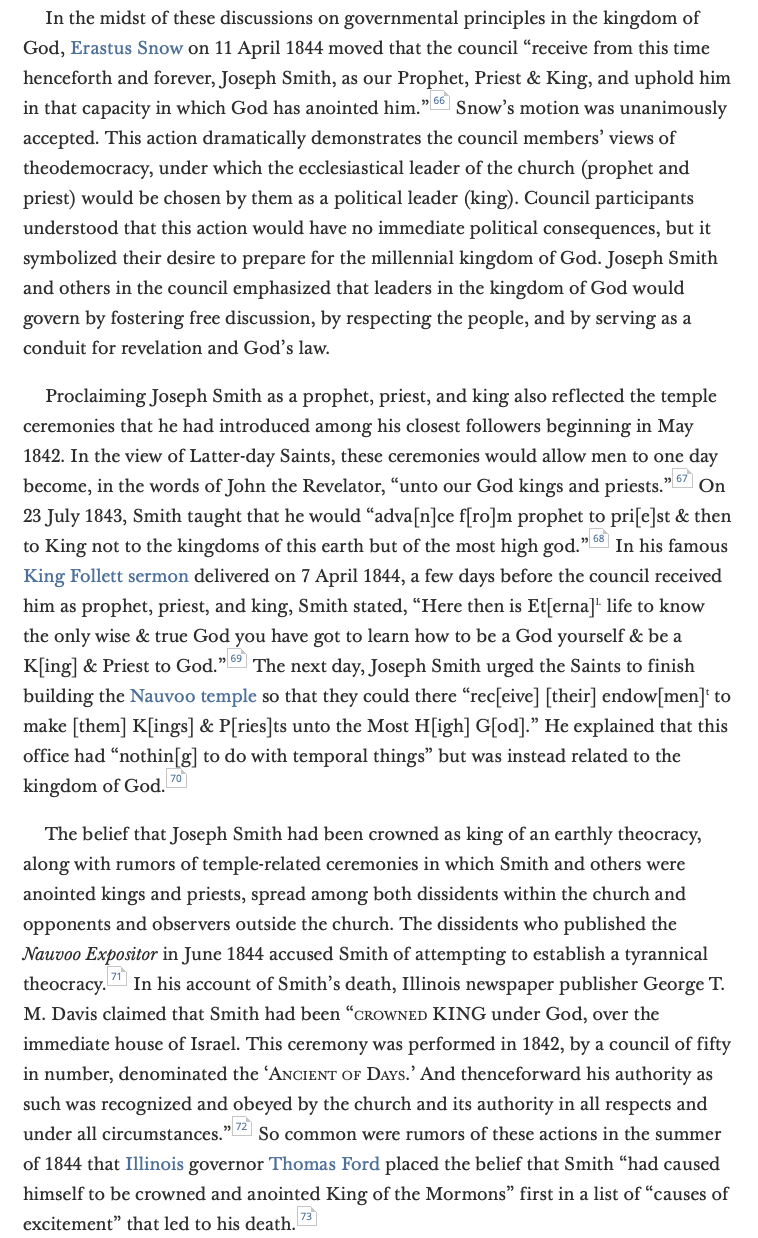The Joseph Smith Papers provides a discussion of "second anointings" in the context of the minutes of the Council of Fifty.
- Type
- Book
- Source
- The Joseph Smith Papers LDS
- Hearsay
- Secondary
- Reference
"Council of Fifty, Minutes, March 1844-January 1846," The Joseph Smith Papers, accessed October 27, 2021
- Scribe/Publisher
- Church Historian's Press
- People
- Mark Ashurst-McGee, King Follett, Gerrit Dirkmaat, The Joseph Smith Papers, George T. M. Davis, Ronald K. Esplin, Joseph Smith, Jr., Matthew J. Grow, Erastus Snow, Thomas Ford, Jeffrey D. Mahas
- Audience
- Reading Public, Members of The Church of Jesus Christ of Latter-day Saints
- Transcription
In the midst of these discussions on governmental principles in the kingdom of God, Erastus Snow on 11 April 1844 moved that the council “receive from this time henceforth and forever, Joseph Smith, as our Prophet, Priest & King, and uphold him in that capacity in which God has anointed him.” Snow’s motion was unanimously accepted. This action dramatically demonstrates the council members’ views of theodemocracy, under which the ecclesiastical leader of the church (prophet and priest) would be chosen by them as a political leader (king). Council participants understood that this action would have no immediate political consequences, but it symbolized their desire to prepare for the millennial kingdom of God. Joseph Smith and others in the council emphasized that leaders in the kingdom of God would govern by fostering free discussion, by respecting the people, and by serving as a conduit for revelation and God’s law.
Proclaiming Joseph Smith as a prophet, priest, and king also reflected the temple ceremonies that he had introduced among his closest followers beginning in May 1842. In the view of Latter-day Saints, these ceremonies would allow men to one day become, in the words of John the Revelator, “unto our God kings and priests.” On 23 July 1843, Smith taught that he would “adva[n]ce f[ro]m prophet to pri[e]st & then to King not to the kingdoms of this earth but of the most high god.” In his famous King Follett sermon delivered on 7 April 1844, a few days before the council received him as prophet, priest, and king, Smith stated, “Here then is Et[erna]l. life to know the only wise & true God you have got to learn how to be a God yourself & be a K[ing] & Priest to God.” The next day, Joseph Smith urged the Saints to finish building the Nauvoo temple so that they could there “rec[eive] [their] endow[men]t to make [them] K[ings] & P[ries]ts unto the Most H[igh] G[od].” He explained that this office had “nothin[g] to do with temporal things” but was instead related to the kingdom of God.
The belief that Joseph Smith had been crowned as king of an earthly theocracy, along with rumors of temple-related ceremonies in which Smith and others were anointed kings and priests, spread among both dissidents within the church and opponents and observers outside the church. The dissidents who published the Nauvoo Expositor in June 1844 accused Smith of attempting to establish a tyrannical theocracy. In his account of Smith’s death, Illinois newspaper publisher George T. M. Davis claimed that Smith had been “crowned KING under God, over the immediate house of Israel. This ceremony was performed in 1842, by a council of fifty in number, denominated the ‘Ancient of Days.’ And thenceforward his authority as such was recognized and obeyed by the church and its authority in all respects and under all circumstances.” So common were rumors of these actions in the summer of 1844 that Illinois governor Thomas Ford placed the belief that Smith “had caused himself to be crowned and anointed King of the Mormons” first in a list of “causes of excitement” that led to his death.
- Citations in Mormonr Qnas
The B. H. Roberts Foundation is not owned by, operated by, or affiliated with the Church of Jesus Christ of Latter-day Saints.

